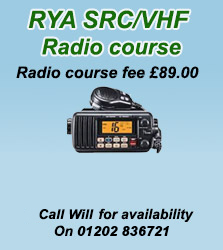
Sound signals in reduced visibility (fog)
The best way to remember these sound signals is to split them by ship condition:
1. Making way and unrestricted in their ability to manoeuvre:
2. Making way but restricted in their ability to manoeuvre;
3. At anchor or underway but not making way; or finally aground
The first set - Making way and unrestricted in their ability to manoeuvre
The only boats classed as unrestricted in their ability to manoeuvre are power boats of all shapes and sizes, making way, but not engaged in any restrictive works such as fishing, dredging or towing, nor constrained by their draft.
Ships in this state all should make the same sound signal : One long blast every two minutes or less.
A ship or boat that is merely stationary but not at anchor (underway, but not making way) gives two long blasts every two minutes or less.
A pilot boat, for some reason, is allowed to add a further signal to its powerboat sound – four short blasts.
You don´t have to worry to much about the size of the vessel. The blast the Queen Mary II makes will not be confused with the sound your berth neighbour´s Sea Ray emits.
It is worth remembering the very large ships can neither turn, stop or reverse in order to avoid you. So if you hear a ‘large vessel blast’ you should be extra alert.
The second set – Making way but restricted in their ability to manoeuvre
This covers lots of boat types. Power boats engaged in work that makes them less manoeuvrable such as boats fishing, dredging, and towing, ships constrained by their draft and all sailing boats.
These ships and boats sound as follows. One long blast followed immediately by two short blasts (again, every two minutes or less).
Towing vessels should make an additional sound signal to alert other shipping to the extra hazard they represent. While the towing vessel makes the sound for a vessel restricted in its ability to manoeuvre, the vessel being towed has a sound signal all of its own and that is one long blast followed immediately by THREE short blasts. These sounds should be co-ordinated into a set. The towing vessel should do its one long and two short and then, after a SHORT pause, the vessel being towed should emit one long and three short blasts.
The third set: At anchor or aground
Ships at anchor and ships aground do NOT use the hooter. They sound bells and gongs, although, if they become alarmed, they may add a supplementary sound signal via their hooter.
Ships under 100m, at anchor, ring a bell for 5 seconds at least every minute. Ships longer than 100m ring the bell at the bow end and follow it with beating a gong for five seconds at the stern.
If the ship is aground, rather than at anchor, it should preceed and follow the rapid ringing with three single strikes. If over 100m, the same goes for the gong.
If they become concerned that an approaching vessel is on a collision course, they may add one short, one long and one short blast from their hooter.
That means that a ship over 100m aground and alarmed you might be on a collision course will do the following:
1. Three distinct strikes of a bell;
2. Rapid ringing of the bell for 5 sec;
3. Three distinct strikes of the bell;
4. Three distinct strikes of the gong;
5. Rapid striking of the gong for 5 sec;
6. Three distinct strikes of the gong; and
7. One short, one, long and one short blast from its hooter.
That ought to get your attention!
Season 2023/24
Season 2023/24
Call Will for all boat training requirements on
01202 836721

Bespoke Tuition to suit your requirements, can also include crew training on your boat.
Call Will to discuss on
01202 836721
Our Details:
Saltwater Experience
Bailey Bridge Marina,
10 Bailey Drive,
Christchurch,
Dorset BH23 2BN
Tel: 01202 836721
Principal: Will Eveleigh
Chief Instructor: Lloyd James





